2004 was the end of an era for arcades. The Neogeo had an astonishing 14 year run, a
true testament to its power, but after Samurai Shodown 5 Special, SNK decided
that it was time to move forward in their arcade technology so they started
using Sammy/Sega’s Atomiswave, an awesome system that allowed for an excellent
fusion of 2D and 3D visuals, not unlike the NAOMI system. Outside of the games SNK would make for it,
it had games like Dolphin Blue, Arc System Works’ Fist of the North Star game
and DIMP’s The Rumble Fish. All in all
it was a great home for SNK to make bigger and better arcade games.
What did Capcom have?
Capcom was doing very well for themselves on home consoles
and came out with some of the greatest games of all time, like the Viewtiful
Joe franchise, Resident Evil 4 and Haunting Ground. The arcades didn’t get any of the action from
them during this time, partially for reasons I’ve already explained regarding
home console hardware catching up and partially because as much success as
Capcom saw, this was also an era of Capcom idiocy.
“People didn’t like our half-assed asset recycle bin
fighting game?! Clearly the people don’t
want arcade games!”
“People didn’t like our already mediocre game about Japanese warlords?! But we edited the entire setting with no context to replace it, made the music worse, changed the gameplay and even cut content! Clearly those stupid Americans don’t want it! What they want is Beatdown: Fists of Vengeance!”
“Hey, Hideaki Istuno! I have some stuff here left over from the guy who bailed! Make a sequel to Devil May Cry in a few months, will you?”
“People didn’t like our already mediocre game about Japanese warlords?! But we edited the entire setting with no context to replace it, made the music worse, changed the gameplay and even cut content! Clearly those stupid Americans don’t want it! What they want is Beatdown: Fists of Vengeance!”
“Hey, Hideaki Istuno! I have some stuff here left over from the guy who bailed! Make a sequel to Devil May Cry in a few months, will you?”
Capcom would eventually make a big comeback to arcades with
one game in particular, but that wouldn’t come out until 2008, so until then we
got 4 different games on the Atomiswave for SNK to build their portfolio with
for this stretch of time before Capcom entered the picture again to challenge
SNK’s arcade dominance.
2005
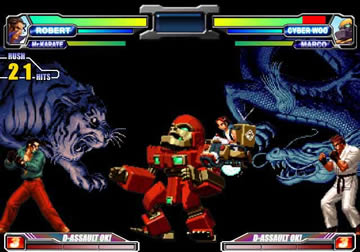 |
| This must be the Ryuuko no Ken. |
Capcom Fighting Evolution ripped all but one character
straight out of other games and it made for huge clash of art styles, but for Neogeo
Battle Coliseum, SNK went out of their way to make new sprites for the majority
of its cast. Some are obviously carried
over from The King of Fighters and SVC Chaos, but all the characters that got
new sprites and animations outweigh the re-uses. They even gave characters like Ryo and Robert
new sprites when they didn’t have to and in the case of Ryo it’s because it’s
the older Ryo (who inherits the name Mr. Karate) from the Hyper Neogeo 64 game
Buriki One.
With NBC I get the feeling it was more about what was truly
a wide selection of Neogeo history over what they could rip from other games,
really showing how much of a labor of love it is. To name a few, it has Cyber Woo from King of
the Monsters 2, Kisarah from Aggressors of Dark Kombat and the Metal Slug hero
Marco, all of whom bring their moves from their respective games with them to
clash with characters from Samurai Shodown, The Last Blade, Fatal Fury and
KOF. The two heroes of Neogeo Battle Coliseum also utilize
objects and devices from throughout SNK’s history.
Capcom Fighting Evolution had players fight Pyron as the
final boss, who played a little differently from his game of origin, but was
still ripped straight from Darkstalkers with nothing new. Neogeo Battle Coliseum has 4 different final
bosses, all of whom have all-new sprites.
They’re very aggravating final bosses that heal damage almost instantly,
forcing you to use the health reduction continue bonus, but the effort was
there. 2 of them are final bosses taken
straight from older SNK fighting games and one is a man-made simulacrum of one
such final boss, further painting NBC as a celebration of Neogeo history.
In CFE, endings were just drawn comic panels over a lame
guitar track. I think Neogeo Battle
Coliseum is overall better with its endings, but you could argue in CFE’s favor
for this aspect. The worst part of NBC’s
arcade endings is that it’s another game in which you’re expected to be
ridiculously good to reach the requirement to fight the true final boss. Arcade mode
is a time trial where you have to try and beat as many opponents as you can
before the timer runs out. You can get a
provision every 3 wins, like more time, and depending on how many teams you
beat and how many of the provisions you used, you fight one of the final
bosses, each of whom gets an introduction and an ending for when they are
defeated, with some fantastic hand-drawn art.
We’re no longer dealing with pixel art on the Atomiswave.
However, only defeating the true final boss of the game, the main villain Goodman, who is extremely hard to get to, will give you your character’s endings and even then those endings are scrolling text. The text endings convey nice closure, character cameos and references that will please fans of each character, but they didn’t even try to make the character endings finish the game off on a high note. Would having the text scroll over a a piece of artwork for the character be too much to ask?
It’s a trade-off situation when compared to Capcom Fighting Evolution. Instead of a bunch of images with no text, NBC is a bunch of text with no images. I still like NBC’s endings more because at least the text conveys a story while the CFE endings are random events irrelevant to the rest of the game.
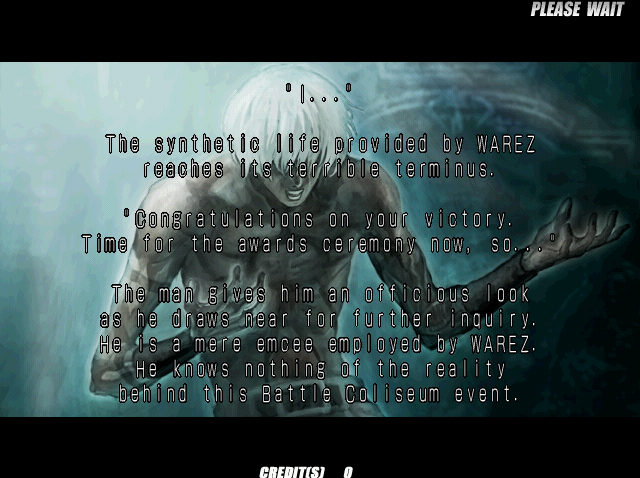 |
| The text also scrolls too fast. |
I love what Neogeo Battle Coliseum does as a celebration of
14 years of the Neogeo systems, but it’s clearly targed squarely at the fans. If you’re not big on Neogeo games then it’s good,
but has a lot less appeal.
Samurai Shodown 6(SNK): If Neogeo Battle Coliseum was a celebration
of the eponymous system, Samurai Shodown 6 is a celebration of its eponymous
(2D) franchise. It’s a non-canon game with
every single character that has ever been in a 2D Samurai Shodown game and uses
a style system similar to Capcom vs. SNK 2’s grooves, where you can make any
character play like any previous 2D Samurai Shodown game, with a couple new
styles thrown in for good measure. This
means the Samurai Shodown 2 style system lets you break your opponent’s weapon
and use the toy transformation command for yucks, you can have the maneuvering
button from 5 or you can go for the plain old Samurai Shodown 1 style, which
does practically nothing but make you deal more damage. You can play who you want how you want.
Samurai Shodown 6 is definitely not starved for content, but
the reason I can’t put it as my favorite is because it doesn’t feel like a
Samurai Shodown game. It’s a celebration
and the plot is that Yoshitora throws a big worldwide fighting festival for
everyone to have fun at. As such, the
game is bright and colorful, all the venues have spectators, the music is more
energetic and there is no blood or dismemberment. Hit effects are done with lights and dry slash
sound effects like in an Arc System Works game.
In fact, the gameplay itself feels like someone played Guilty Gear and
thought Samurai Shodown should be more like it.
I think one of the new styles even gives you a Guilty Gear-type gatling
combo.
The original idea of feeling the weight of the blade is gone. A heavy slash does about as much damage as a
fierce punch does in Street Fighter instead of blowing away half of a player’s
health. There’s less hit stop and
recoil, players move quicker and it’s even possible to air juggle, something
the final boss really loves doing.
Instead of fights being intense staredowns as both players try to land
the perfect hit, they’re speedy clashes of characters running up and down the
stage applying pressure, trading blows and using the occasional item that gets
thrown on the stage.
This doesn’t make it a bad game so much as a different
one. As a fast-paced weapon-based 2D
fighting game, it’s great in its own right, but it can be jarring if you go
into it expecting a Samurai Shodown game like the previous ones. If you can accept that and maybe treat it as
a spin-off (as seems to be the case in Japan
The King of Fighters 11(SNK)
Take everything that made The King of Fighters 2003 good and
amplify it to new heights. KOF 11 is
easily one of the very best fighting games ever made. It has a huge character roster, bringing back
several, introducing new ones like Elizabeth and Oswald plus there are even
more mid-bosses you can fight, making one of the biggest character selections
in any game played thus far.
It continues the story from where KOF 2003 left off and ups
the story presentation. The artwork is
now hand-drawn and scanned into the game without the need of pixel art, making
the cutscenes absolutely gorgeous and the story itself has big twists to
prepare for the next not-disgraceful game in the series. The bosses Magaki and Shion are an effective
pair of villains for the story. They may
not get a lot of character development, but they play an important role in
painting the greater picture of the underlying villains and both are unique and
memorable in how they look and fight.
Magaki has a lot of design parallels to Mukai, which highlights
them being of the same race.
Backgrounds are gorgeous, lively and varied. They’re some of the best stages in the
franchise and the music matches that quality with a soundtrack topping even KOF
99, with not a single bad track among them.
Of course, the gameplay saw an update as well. Once again it’s a fast-paced tag-team
fighter, now with even more tag options, more ways to cancel into other moves
and they brought back the blowback attack by giving it its own dedicated button
(even though they could’ve just made it the same button command as previous
games).
It’s hard to find anything to criticize it for. Everything from the looks to the sound to the
controls is the best KOF has ever been.
Everyone should play The King of Fighters 11.
2006
Metal Slug 6(SNK): By every measure, I should love
this game. It should be my favorite
Metal Slug game. It’s on a stronger
system, it returns to the plotlines of the best games in the franchise, it adds
Ralf fuckin’ Jones and every character has their own special ability.
About that…
It does add Ralf Jones, who makes anything better, but Ralf
and fellow Ikari Warrior Clark’s special abilities are situational and the very
implementation of making each character unique caused the biggest downgrade of
all. See, Fio’s ability is that she gets
as much ammo for special weapons as you would in previous games, but everyone
else gets half except Ralf, who gets even less than that. That you can now hold two special weapons to
switch between on the fly doesn’t help the fact that you’re woefully
underequipped in a Metal Slug game, a franchise all about going in with tons of
weapons and blowing stuff up!
What this means is that for a lot of the game you’re forced
to use you pistol, which is not ideal because the invader enemies can take
noticeably more punishment than the regular enemies in previous games. This causes two problems. First, the pacing is slower because there’s a
lot less running and gunning when you have to stop to take down a bunch of
enemies that can tank a lot of handgun fire.
Second, many enemies charge at you and unless you have a special weapon
(the ones with scarce ammo), they will most certainly hit you because they take
so much damage that most of the time you can’t kill them in time and they’re so
big that they’re difficult to get out of the way of.
I think Metal Slug 6 could use a tweaked version in the
style of Metal Slug X, maybe with more ammo drops, different boss behaviors and
small adjustments to make it play smoother.
The potential and ideas are all there, but they come together haphazardly
and make for a frustrating experience. I
guess it’s worth a play to see some of the things it does differently from the
other games, for better or worse, and some of the visuals on the new enemies
and hand-drawn environments are pretty to look at, but Metal Slug 6 isn’t up to
the standards of the Neogeo games.
SNK has gotten a serious leg up on Capcom for this competition. They outclassed their inter-company crossover fighting game AND made one of the best fighting games ever. Next time we'll see how Capcom responds to that in 2008 and whether their efforts will be able to surpass SNK's for this period of time.

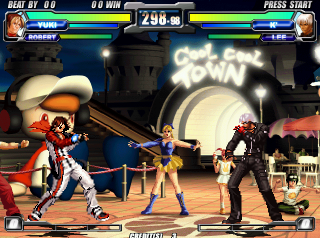

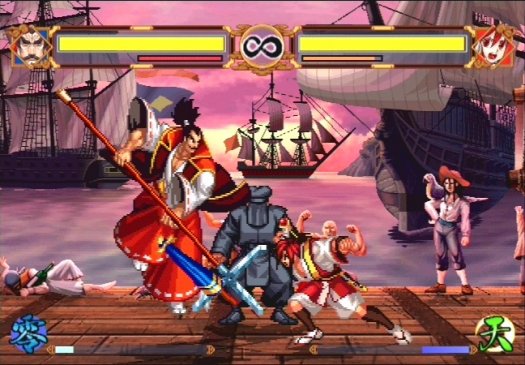
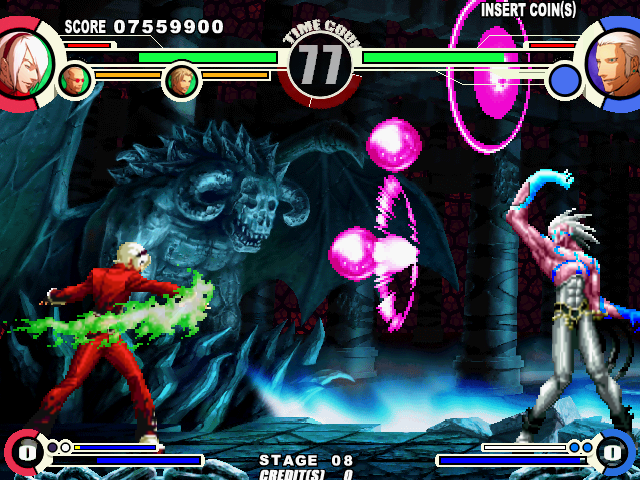
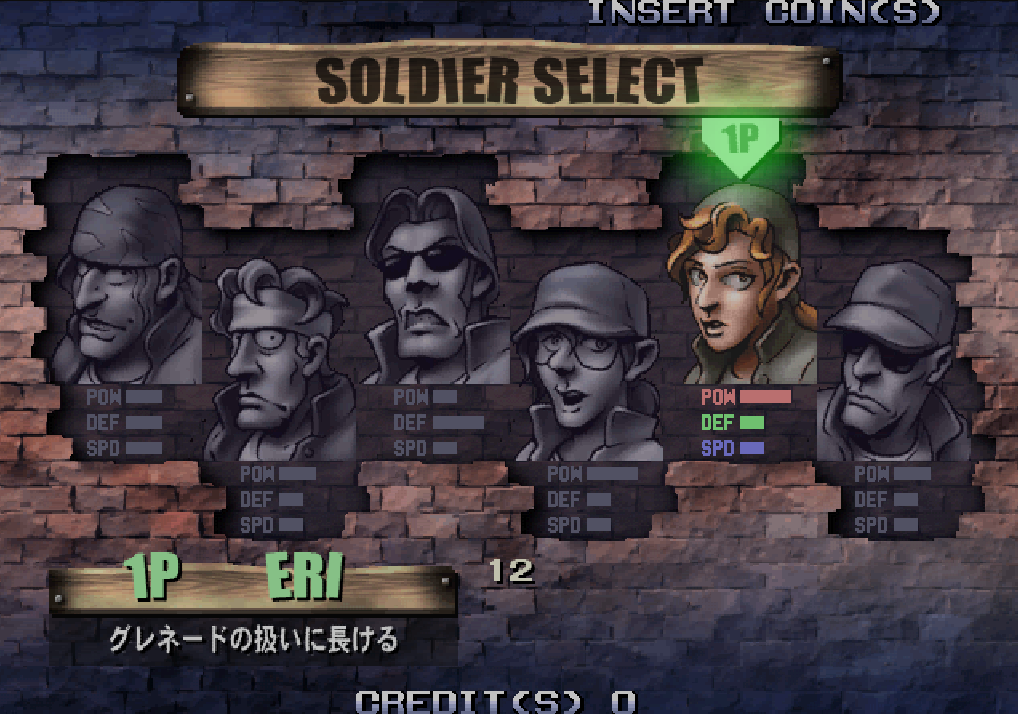

No comments:
Post a Comment